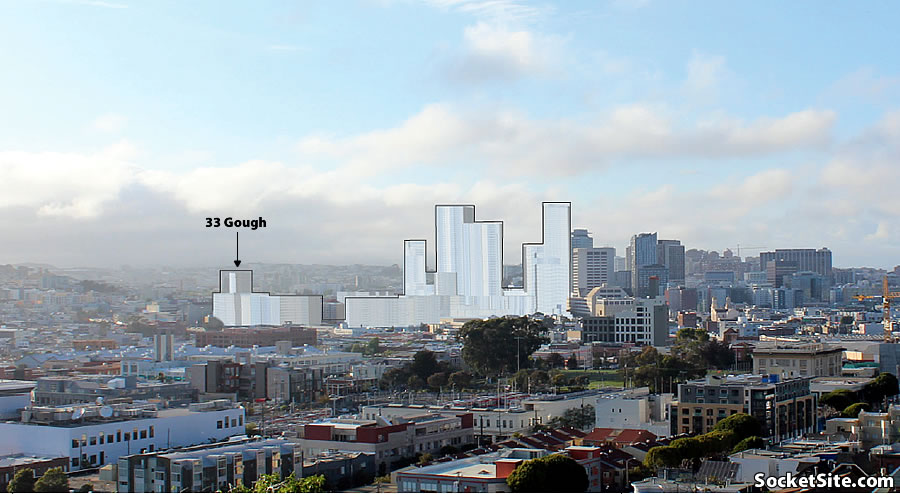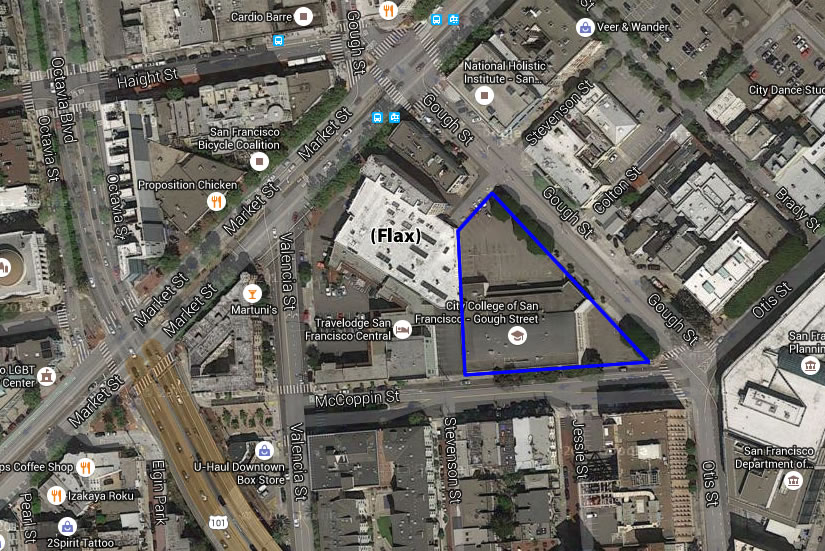While City College of San Francisco has already picked a development team to long-term lease and redevelop their 46,000-square-foot parcel at 33 Gough Street, behind the Flax site to rise up to 85 feet in height, the College is quietly working on near-term plans to vacate and lease its existing two-story office building on the site to a non-public entity, or entities, for up to three years.
From the City College of San Francisco’s General Counsel in a letter to the City seeking confirmation that their near-term plan for the site would be allowed:
“We plan to relocate our administrative functions from the Property and have entered into an Exclusive Negotiating Agreement…to ground lease the Property to the [Equity Community Builders and Integral] in order to provide income to the District in furtherance of our educational mission.
The developer will pursue land use entitlements (including a rezoning) of the Property and then redevelop the Property as a multi-family residential project with on-site affordable units.
We believe that the rezoning and entitlement process and then financing and commencement of construction will take several years for the developer to complete, particularly given the Planning Department’s recent initiation of the Van Ness and Market “Hub” study. During that period, the District will have vacated most or all of its occupancy of the existing building. We desire both that the building not sit vacant and be subject to vandalism during this interim period and that use of the building by other private office/administrative users be able to generate needed income…”
In addition to currently being zoned for Public use, the current height limit for the parcel is 85 feet, which could accommodate the development of over 200 units of housing.
But as part of the City’s recently launched Market Street Hub Project, the parcel is proposed to be upzoned for development up to 200 250 feet in height.


This is just me but, from whatever angle it is rendered, it’s more and more clear the Hub should not be tendered – as a serious proposal for adding housing stock.
To whit, under existing height/density rules the CCSF site will yield more than 200 units of housing. The Flax site is projected for a little less than 200. Together 400 units of much needed housing stock.
If the Central SOMA was built out on just half its blocks how many housing units would that yield? 6000 plus?
The Central SOMA could become a moderate density district with potentially a wide mix of architecture given the large number of medium sized projects. Not to mention retention of some more historic buildings. Think the Pearl district.
A real mix. A neighborhood of congenial facades, one that afforded glimpses of the blue sky above. As opposed to blocks of dead corridors hemmed in by 40 story buildings.
Its begs the question why the Hub is even a serious proposal when a more workable and environmentally & human friendly option is available. It’d also be less financially risky.
6000 units in Central SOMA, 4000 on TI. 2000 in the Giants complex. HP – 3000 (?), PM an additional 4000. There are lots more than the ones I mentioned (UCSF building more than 1K units near their MB campus), but these alone would provide around to 25K units of new housing – including the 5K coming online this year.
Food for thought.
Why isn’t the hub workable?
Central SoMa is already much denser than the Pearl District. It has about twice the population (12k vs 6k, per 2010 Census) in about 80% of the area (250 acres vs 300 acres). It also has a lot more jobs (~50k). The Pearl District has a density around the same as the inner suburban neighborhoods of SF, not the CBD, of which Central SoMa is a part.
FTR, the draft plan for the “Central Corridor” of SoMa calls for adding 11,715 new housing units and 47k new jobs.
If you want SoMa to emulate the Pearl District based on population density, then you better advocate for much lower densities than now, not higher. Sounds like you want to take us back to the pre-dotcom densities of SoMa. FWIW, SoMa was funkier with a higher fun-to-work ratio with much more of an arts/music/club scene in those days. All work and no play packed elbow to elbow cranking out unicorns leaves the Miss Congenitally Award race to other cities with less lofty RE and stock valuations.
i would like to see the western SOMA plan tossed and all of western SOMA to be zoned to 12-15 floors
I hope it doesn’t get tossed out. It is working well within the scale and density allowed, now.
Why are so many people here CONTINUALLY pushing to higher and higher and more and more growth? Let the entire Bay Region start to absorb some of this as well.
Rather NIMBY there, aye? Trouble is, every city in the Bay Area has people with that delightful “let everyone else do something” attitude, which means nothing happens.
For starters can San Mateo County step up?
El Camino from SSF to Millbrae is a one and two story commercial corridor. El Camino is wider in many parts than any SF street/avenue.
El Camino is blocks from the Colma and SSF BART stations. it is a short drive up to 280 and a bit longer drive to 101.
This long strip is devoid of much development. A few 5/6 story condo projects have been built in recent years, but SMC needs to do more. As you say, SF can’t absorb the lion’s share of this growth. Technically it can but in doing so the quality of life in SF will continue to deteriorate.
yeah, we know you want it tossed to allow for taller. You’ve said it, what, a few dozen times on SS. We also know it won’t be tossed.
Sheesh, after western SoMa gets the impact from the beast being unveiled at 8th/Harrison (largest uncarved kidney stone in SF) added to the accumulating impact of all the over development from there south to the foot of Potrero, with no more of a transportation upgrade than converting traffic lanes to bile lanes, there is more likely to be a political shift to how to move the people housed in these monoliths than how to make more of them and taller.
I also hope it gets tossed out. As someone who’s lived in SOMA for the past seven years, the current plan is NOT working well— most of SOMA is still a barren landscape that can bare a lot more, SOMA is a centrally-located neighborhood, oh and hey we have a housing crisis. And I’d love more people on the streets here.
but yes, let’s listen to the noe valley peeps, looking down from the hill, talk about how it’s “working well.” What metrics are you using?
There may be 25k units being constructed, but will it be enough? We will see if prices come down to a level which is affordable. It seems unlikely to me.
So I think it’s a bit premature to call for reducing the amount of future housing, and I will favor bigger buildings in those few locations it’s even remotely likely to happen, even if it means sacrificing “glimpses of the blue sky above” in those places.
The Hub is a great idea and it will get done. Central SoMa will pass with the high-rise alternative, expecting developers to upzone it even more (500-600 feet) with additional affordable housing in the plans.
Comparing SOMA and the Pearl District is ridiculous. it’s Portland’s North Beach both geographically and culturally.
SOMA, unfortunately, has the added function of funneling tens of thousands of vehicles (private and transit) in and out of the CBD including the vital transbay link. It’s inescapable and, while certainly aiming to mitigate the effects to create a more enjoyable neighborhood, any planning must take its accommodation into account.
Soma is a big parking lot and freeway feeder system. Short of numerous road diets, Its magic lies in its enormous networks of alleys & lanes which should be mixed use, and allow somewhat larger residential building. With another 100,000 residents arriving in and around SOMA in next 5 years – a veritable parking lot is in the making.
If you’re parading around in an SUV you might be immune, but woe to pedestrians & cyclists or any thinking SOMA is or will become anything but a neighborhood.
Get out of your cars and experience the vacant ,noisy traffic-numbing area.
And isn’t that the problem – the large influx of anticipated residents into SF w/o the appropriate infrastructure to handle them. BART at capacity, BB at rush hour capacity. Roads around RH already at a standstill with traffic at rush hour.
Meanwhile the City is trying to increase density in a huge way in areas like the Hub. I won’t even get into the Warriors’ arena proposal.
And meanwhile still, the drive down El Camino from SSF to Burlingame is and will apparently remain bucolic by comparison.
I don’t get it – CCSF lost its accreditation, and then saw its full-time enrollment drop by 30%. It’s barely hanging on financially and is currently being bailed out by the state. So, the natural thing, of course, is for them to develop a new building at the very peak of this real estate cycle? And, by the way, supervisor Jane Kim is showing her political stripes by proposing that taxpayers should pay for free tuition for this unaccredited institution? Which part of this makes any sense?
here’s a little background on CCSF’s situation.
“have entered into an Exclusive Negotiating Agreement…” = makes a lot of $$$ sense if you are the developer. 🙂
UPDATE: The Towering Plans for the City College Site on Gough